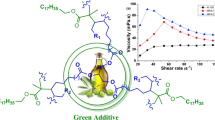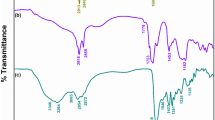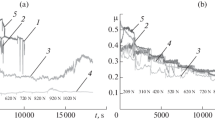Abstract
Lubricating additives play a pivotal role in automobiles and industrial machines. The present work describes the design and synthesis of three copolymeric lubricating additives using alkyl acrylates (Ac) and simulated feed containing 33% long-chain α-olefins (LCAO) in n-paraffins. The alkyl acrylates (C6, C10, and C16Ac) and α-olefins are taken in a 1:1 molar ratio, and the three different polymers P1, P2, and P3 are synthesized in a solvent-free medium by the free radical polymerization using benzoyl peroxide (BPO) as initiator. The polymeric additives (P1, P2, and P3) are blended with base oils, and their performances, such as density, pour point, viscosity index (VI), and corrosion properties were studied. The synthesized polymeric additives are miscible with base oils excellently, and they do not change the density of base oil and depress the pour point of the base oils. All the polymeric additives are successful in depressing the pour points of base oils. The pour point of BO-1 is −21, and the use of P1 depresses the pour point to ≤ 27 at 4000 ppm. However, P3 exhibits the best performance even at low concentration (2000 ppm) by depressing the pour point value to ca. 12 °C and 15 °C in case of BO-2, BO-3, respectively. In terms of viscosity index, P1 shows the better results at 6000 ppm concentration by increasing the VI by 13.9% compared to P2 and P3, which is a maximum increase in VI among different base oils used for study. Increasing the concentration of polymeric additives in base oils reduces the corrosion as per the standard corrosion test method ASTM D130-12.
Graphic abstract

Synthesis of the copolymeric additives composed of alkyl acrylates and LCAO under solvent-free conditions by the free radical polymerization, which shows a potential eco-friendly additive for base oils, was demonstrated. The alkyl acrylate and LCAO appendage on polymeric additive enabled better miscibility and transparency with base oils and without modifying the nature of base oils. Polymeric additive blended base oils show superior properties in terms of increasing the viscosity index, depressing the pour point and anticorrosion. This has the potential of exploration in pour point depressants in petroleum industry.







Similar content being viewed by others
References
Fuchs M (2000) The world lubricants market, current situation and outlook. In: Proceedings of the 12th International Colloquium on Tribology
Jung KM, Chun BH, Park SH, Lee CH, Kim SH (2011) Synthesis of methacrylate copolymers and their effects as pour point depressants for lubricant oil. J Appl Polym Sci 120(5):2579–2586
Ghosh P, Das T, Nandi D, Karmaka G, Mandal A (2010) Synthesis and characterization of biodegradable polymer– used as a pour point depressant for lubricating oil. Int J Polym Mater 59(12):1008–1017
Ghosh P, Das T (2011) Copolymer of decyl acrylate and styrene: synthesis, characterization and viscometric studies in different base stocks. Adv Appl Sci Res 2(2):272–283
Akhmedov AI (1994) Copolymer of alkyl methacrylates with styrene as V. I. improvers for lubricating oils. Chem Tech Fuels Oil 30:34–37
Jerbic IS, Vukovic JP, Jukic A (2012) Production and application properties of dispersive viscosity index improvers. Ind Eng Chem Res 5(37):11914–11923
Abdel-Azim AAA, Abdel-Aziem RM (2001) Polymeric additives for improving the flow properties and viscosity index of lubricating oils. J Polym Res 8:111–118
Nassar AM (2008) The behavior of polymers as viscosity index improvers. Pet Sci Technol 26(5):514–522
Singh RK, Kukrety A, Kumar A, Chouhan A, Saxena RC, Ray SS, Jain SL (2018) Synthesis, characterization, and performance evaluation of N, N-Dimethylacrylamide–alkyl acrylate copolymers as novel multifunctional additives for lube oil. Adv Polym Technol 37(6):1695–1702
Singh RK, Kukrety A, Chatterjee AK, Thakre GD, Bahuguna GM, Saran S, Adhikari DK, Atray N (2014) Use of an acylated chitosan schiff base as an ecofriendly multifunctional biolubricant additive. Ind Eng Chem Res 53(48):18370–18379
Sánchez R, Stringari GB, Franco JM, Valencia C, Gallegos C (2011) Use of chitin, chitosan and acylated derivatives as thickener agents of vegetable oils for bio-lubricant applications. Carbohydr Polym 85(3):705–714
Nagendramma P, Kaul S (2012) Development of ecofriendly/biodegradable lubricants: an overview. Renew Sustain Energy Rev 16(1):764–767
Karmakar G, Ghosh P (2013) Green additives for lubricating oil. ACS Sustain Chem Eng 1(11):1364
ASTM D97–15, (2015) In: Annual book of ASTM standards (Eds: Baldini NC, Barkley EI, Brecht LM, Leinweber CM, Mayer VA, Peters KA, Whealen EA, Wilhelm RF), ASTM International: West Conshohocken, PA
ASTM D2270-93, (1998) In: Annual book of ASTM standards (Eds: Baldini NC, Barkley EI, Brecht LM, Leinweber CM, Mayer VA, Peters KA, Whealen EA, Wilhelm RF), ASTM International: West Conshohocken, PA
ASTM D130-12, (2012) Standard test method for corrosiveness to copper from petroleum products by copper strip test. In annual book of ASTM standards; ASTM international: West Conshohocken, PA
Acknowledgements
We kindly acknowledge the Director of CSIR-IIP for his kind permission to publish these results. The authors are thankful to CSIR-IIP India, for financial support through the in-house project OLP1041. The authors are also grateful to Analytical Science Division of CSIR-IIP, Dehradun, for analytical support.
Author information
Authors and Affiliations
Corresponding author
Additional information
Publisher's Note
Springer Nature remains neutral with regard to jurisdictional claims in published maps and institutional affiliations.
Supplementary Information
Below is the link to the electronic supplementary material.
Rights and permissions
About this article
Cite this article
Kukrety, A., Sharma, B., Senthilkumar, T. et al. Design, synthesis, and performance evaluation of poly(long-chain α-olefin-co-acrylates) as multifunctional additives for lubricating base oils. Polym. Bull. 79, 4827–4840 (2022). https://doi.org/10.1007/s00289-021-03738-2
Received:
Revised:
Accepted:
Published:
Issue Date:
DOI: https://doi.org/10.1007/s00289-021-03738-2




